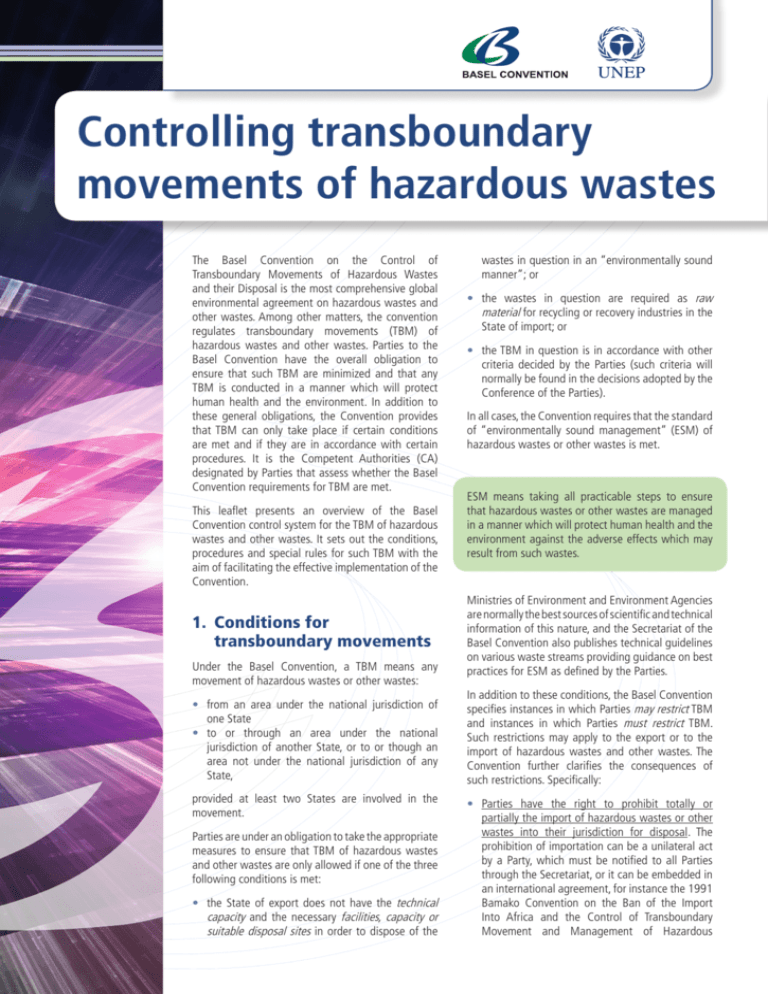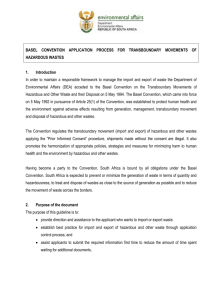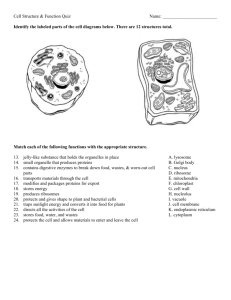Controlling transboundary movements of
advertisement

Controlling transboundary movements of hazardous wastes The Basel Convention on the Control of Transboundary Movements of Hazardous Wastes and their Disposal is the most comprehensive global environmental agreement on hazardous wastes and other wastes. Among other matters, the convention regulates transboundary movements (TBM) of hazardous wastes and other wastes. Parties to the Basel Convention have the overall obligation to ensure that such TBM are minimized and that any TBM is conducted in a manner which will protect human health and the environment. In addition to these general obligations, the Convention provides that TBM can only take place if certain conditions are met and if they are in accordance with certain procedures. It is the Competent Authorities (CA) designated by Parties that assess whether the Basel Convention requirements for TBM are met. This leaflet presents an overview of the Basel Convention control system for the TBM of hazardous wastes and other wastes. It sets out the conditions, procedures and special rules for such TBM with the aim of facilitating the effective implementation of the Convention. 1.Conditions for transboundary movements Under the Basel Convention, a TBM means any movement of hazardous wastes or other wastes: • from an area under the national jurisdiction of one State • to or through an area under the national jurisdiction of another State, or to or though an area not under the national jurisdiction of any State, provided at least two States are involved in the movement. Parties are under an obligation to take the appropriate measures to ensure that TBM of hazardous wastes and other wastes are only allowed if one of the three following conditions is met: • the State of export does not have the technical capacity and the necessary facilities, capacity or suitable disposal sites in order to dispose of the wastes in question in an “environmentally sound manner”; or • the wastes in question are required as raw material for recycling or recovery industries in the State of import; or • the TBM in question is in accordance with other criteria decided by the Parties (such criteria will normally be found in the decisions adopted by the Conference of the Parties). In all cases, the Convention requires that the standard of “environmentally sound management” (ESM) of hazardous wastes or other wastes is met. ESM means taking all practicable steps to ensure that hazardous wastes or other wastes are managed in a manner which will protect human health and the environment against the adverse effects which may result from such wastes. Ministries of Environment and Environment Agencies are normally the best sources of scientific and technical information of this nature, and the Secretariat of the Basel Convention also publishes technical guidelines on various waste streams providing guidance on best practices for ESM as defined by the Parties. In addition to these conditions, the Basel Convention specifies instances in which Parties may restrict TBM and instances in which Parties must restrict TBM. Such restrictions may apply to the export or to the import of hazardous wastes and other wastes. The Convention further clarifies the consequences of such restrictions. Specifically: • Parties have the right to prohibit totally or partially the import of hazardous wastes or other wastes into their jurisdiction for disposal. The prohibition of importation can be a unilateral act by a Party, which must be notified to all Parties through the Secretariat, or it can be embedded in an international agreement, for instance the 1991 Bamako Convention on the Ban of the Import Into Africa and the Control of Transboundary Movement and Management of Hazardous Wastes Within Africa which prohibits the import of hazardous wastes into Africa from non-contracting Parties. Notifications of import restrictions and notifications of agreements transmitted by Parties to the Secretariat can be found on the website of the Basel Convention. • If a Party restricts or prohibits the import of hazardous wastes or other wastes, other Parties must respect this restriction or prohibition. In line with the Convention, Parties must prevent and not allow the export of hazardous wastes or other wastes to a State or group of States belonging to an economic and/ or political integration organization that has, by legislation, prohibited all imports, or to a Party that has exercised its right to prohibit totally or partially the import of hazardous wastes or other wastes into its jurisdiction for disposal. • A Party must not allow exports to a State when it has reason to believe that the wastes in question will not be managed in an environmentally sound manner. For example, if the proposed destination does not have the appropriate technology to recycle electronic equipment in an environmentally sound manner, the State of export must not allow a shipment described as used computers for recycling to be shipped there. • Parties may decide to limit or ban the export of hazardous wastes or other wastes to other Parties. At its third meeting in 1995, the Conference of the Parties decided to amend the Convention by inserting a new Article 4A commonly referred to as the Ban amendment that prohibits certain TBM under specific conditions. • Parties are prohibited from exporting wastes falling within the scope of the Convention for disposal within the area south of 60° South latitude, whether or not such wastes are subject to a TBM. • A TBM should not occur with a non-Party. Parties shall not permit hazardous and other wastes to be exported to a nonParty or to be imported from a non-Party, unless an agreement or arrangement regarding TBM is in place that provides for the ESM requirement to apply. • TBM can take place through transit States that are not Parties to the Convention. However in that case, some elements of the notification procedure apply mutatis mutandis to such TBM: the generator, exporter or State of export is required to notify the competent authority of the State of transit of any proposed TBM. In addition, the Basel Convention requires that only persons authorized or allowed to transport or dispose of wastes undertake such operations, and that wastes subject to a TBM be packaged, labelled and transported in conformity with generally accepted and recognized international rules and standards. 2.Procedures for transboundary movements The Basel Convention contains a detailed Prior Informed Consent (PIC) procedure with strict requirements for TBM of hazardous wastes and other wastes. The procedures form the heart of the Basel Convention control system and are based on four key stages (1) notification; (2) consent and issuance of movement document; (3) transboundary movement ; and (4) confirmation of disposal. Stage 1: Notification The purpose of stage 1 is for the exporter to properly inform the importer of a proposed transboundary movement of hazardous wastes or other wastes. GENERATOR Inform of proposed movement Conclude a contract specifying ESM DISPOSER Refuse to allow export COUNTRY OF EXPORT Send Notification Document Send Notification Document COUNTRY OF IMPORT COUNTRY OF TRANSIT The exporter/generator of the wastes must inform the Competent Authority (CA) of the State of export of a proposed shipment of hazardous or other wastes. Before the shipment can be allowed to start the generator and the disposer conclude a contract for the disposal of the waste. Under the Convention this contract must ensure that the disposal is conducted in an environmentally sound manner. The CA of the State of export assesses the information received from the exporter/generator and may refuse to allow the export. Such a decision is perfectly in order with the spirit of the Convention. If the CA of the State of export has no objection to the export, it informs - or requires the generator/exporter to inform - the CA of the States concerned (State of import and State(s) of transit) of the proposed movement of hazardous wastes or other wastes by means of a “notification document”. The purpose of the notification is to provide the CA of the countries concerned with detailed, accurate and complete information on the waste itself, on the proposed disposal operation and other details relating to the proposed shipment. This document must contain the information specified in Annex V A of the Convention, and must be in a language that is acceptable to the State of import and State(s) of transit. Stage 2: Consent & Issuance of movement document The purpose of stage 2 is to ensure that the importer agrees to the proposed transboundary movement and that the appropriate documentation accompanies the shipment of hazardous wastes or other wastes. GENERATOR DISPOSER If consent and proof of contract, then issue Movement Document COUNTRY OF EXPORT Consent/Deny Movement (written) Confirm contract specifying ESM Consent/Deny Movement (written) COUNTRY OF IMPORT COUNTRY OF TRANSIT The CA of the country of import must also confirm to the notifier the existence of a contract between the exporter and the disposer. One of the most important conditions of the notification procedure is the verification of the existence of a legally binding contract between the generator and the disposer, specifying ESM of the wastes in question. The CA of any country of transit must acknowledge promptly receipt and may provide its written consent to the country of export (with or without conditions) or denial within 60 days. Countries of transit may decide not to require prior written consent, in which case the country of export may allow the export to proceed if it does not receive any response from that state of transit after 60 days. Once the relevant CAs have established that all the requirements of the Convention have been met and have agreed to the movement, the CA of the country of export can proceed with the issuance of the movement document and authorize the shipment to start. The movement document contains detailed information about the shipment and must accompany the consignment at all times at the time of departure to the arrival of the consignment at the disposer. Stage 3: Transboundary movement Stage 3 illustrates the various steps that need to be followed once the transboudary movement has been initiated and until the wastes have been received by the disposer. Send signed copy of Movement Document confirming receipt of shipment DISPOSER COUNTRY OF IMPORT COUNTRY OF EXPORT Most countries accept a copy of the duly completed and fully authorized notification to be enclosed with the movement document. However, some countries require than an original notification, stamped and signed by the CA, shall always accompany the movement document. Stage 4: Confirmation of disposal On receipt of the notification document, the CA of the country of import must provide its written consent (with or without conditions) or denial (can ask for further clarification). GENERATOR The Conference of the Parties has recommended that the duly completed notification should always accompany the Movement document. COUNTRY OF TRANSIT The movement document provides relevant information on a particular consignment, for example, on all carriers of the consignment, which customs officers it has to pass through, the type of waste and how it is packaged. It should also provide accurate information on the authorizations by the CAs for the proposed movements of wastes. The purpose of stage 4, the final stage in the TBM procedure, is for the generator and country of export to receive confirmation that the wastes moved across borders have been disposed of by the disposer as planned and in an environmentally sound manner. The Convention requires a confirmation from the disposer when the disposal has taken place, according to the terms of the contract, as specified in the notification document. If the CA of the country of export has not received the confirmation that disposal has been completed, it must inform the CA of the country of import accordingly. GENERATOR COUNTRY OF EXPORT Upon completion, send confirmation that disposal has taken place If no confirmation received, advise accordingly DISPOSER May wish to follow up in order to confirm completion COUNTRY OF IMPORT COUNTRY OF TRANSIT 3.Special rules: application of the mutatis mutandis principle In some instances, Parties may have different views as to whether the control procedure should apply to a particular TBM. This may result of different legal frameworks between countries, or of a different appreciation between countries as to whether the object of a TBM is a “waste” that is “hazardous” in nature. The following scenarios, inter alia, may occur: • Differing definitions of “hazardous wastes” under national legislation: Under paragraph 1 (b) of Article 1 of the Convention, Parties have the right to define as “hazardous wastes” wastes other than those listed in the Annexes of the Convention. In doing so, Parties extend the scope of application of the Convention. The consequence is that some wastes are legally defined as hazardous in one jurisdiction but not in another. • Differing consideration of the “hazardous” characteristic of a waste: Notwithstanding variations between the applicable legal frameworks, it may also happen that Parties have a different appreciation of the hazardous characteristic of a specific waste that is the object of a TBM, with one Party considering that the waste in question is not “hazardous” while another considers that it is. Article 6, paragraph 5 of the Convention aims at providing legal clarity in such circumstances. In the case of a TBM of wastes where the wastes are legally defined as or considered to be hazardous wastes only: • By the State of export, the requirements of paragraph 9 of Article 6 that apply to the importer or disposer and the State of import shall apply mutatis mutandis to the exporter and State of export, respectively. This means that the State of export shall ensure that the disposer issues a certification of receipt of the waste and a certification of the completion of disposal as required by the Convention. This may be done, for example, by requiring these obligations to be included in the contract between the exporter and the disposer. • By the State of import, or by the States of import and transit which are Parties, the requirements of paragraphs 1, 3, 4 and 6 of Article 6 that apply to the exporter and State of export shall apply mutatis mutandis to the importer or disposer and State of import, respectively. This means that the disposer or the competent authority of the State of import shall provide the notification to the competent authorities concerned. Similarly, the competent authority of the State of import shall assume the responsibilities of the competent authority of the State of export. • By any State of transit which is a Party, the provisions of paragraph 4 of Article 6 shall apply to such State. The Convention does not clearly define the procedures to be applied in cases where the waste is legally defined as or considered to be hazardous wastes only by the State of transit. For practical reasons, it is recommended that the exporter or the State of export, through negotiations or by some other means, makes arrangements for the notification to be provided to the competent authority of the State of transit in accordance with the Basel Convention. Detailed flow charts on the steps that must be followed by the various entities concerned by a TBM (generator or exporter, State of export, transit State, disposer and any person taking charge of a TBM) can be found in the Convention’s Guide for the Control System. For further information please contact: Secretariat of the Basel Convention UNEP/SBC International Environment House I 13-15 Chemin des Anémones CH-1219 Châtelaine Geneva, Switzerland Tel: + 41 22 917 8218 | Fax: + 41 22 797 3454 E-mail: sbc@unep.org | www.basel.int Quick links to get additional information: Text of the Basel Convention: http://www.basel.int/ TheConvention/Overview/TextoftheConvention/tabid/1275/Default. aspx Notification and Movement documents: http://www.basel. int/Procedures/NotificationMovementDocuments/tabid/1327/ Default.aspx List of Competent Authorities: http://www.basel.int/Countries/ CountryContacts/tabid/1342/Default.aspx Import and export prohibitions: http://www.basel.int/ Countries/NationalDefinitions/tabid/1480/Default.aspx The ban amendment: http://www.basel.int/Implementation/ LegalMatters/BanAmendment/tabid/1484/Default.aspx Agreements additional to the Basel Convention: http:// www.basel.int/Countries/Agreements/tabid/1482/Default.aspx Technical guidelines on the environmentally sound management of wastes: http://www.basel.int/Implementation/ TechnicalMatters/DevelopmentofTechnicalGuidelines/tabid/2374/ Default.aspx The control system for transboundary movements of hazardous and other wastes: http://www.basel.int/ TheConvention/Publications/GuidanceManuals/tabid/2364/Default. aspx?overlayId=ArtId-165 Preventing and combating illegal traffic in hazardous and other wastes: http://www.basel.int/Implementation/ LegalMatters/IllegalTraffic/tabid/2395/Default.aspx This leaflet was printed as part of the 2009-2011 work programme of the Basel Convention Committee for Administering the Mechanism for promoting Implementation and Compliance with the Basel Convention whereby the Committee was requested, to provide general information and guidance on the Basel Convention website, or through publications, to facilitate, promote, and aim to secure the implementation of Parties’ obligations under articles 3, 4, 5 and 6 of the Convention. The content of this leaflet is based, inter alia, on the Convention’s Guide for the Control System and the Basel Convention Training Manual on Illegal Traffic for Customs and Enforcement Agencies. Designed and printed by the Publishing Service, United Nations, Geneva — GE.11.01803 — December 2011 — 500 — UNEP/SBC/2011/10 • Differing legal and/or factual appreciation of the object of the TBM: is it waste or non-waste? Because the definition of “waste” may vary from one country’s national legislation to another, a certain substance or object may not be defined as waste by all the States concerned by a TBM. In addition, it may also happen that Parties have a different factual appreciation of the nature of the object of a TBM, with one Party considering that it amounts to “waste” while another will consider that it is a good or a product.







